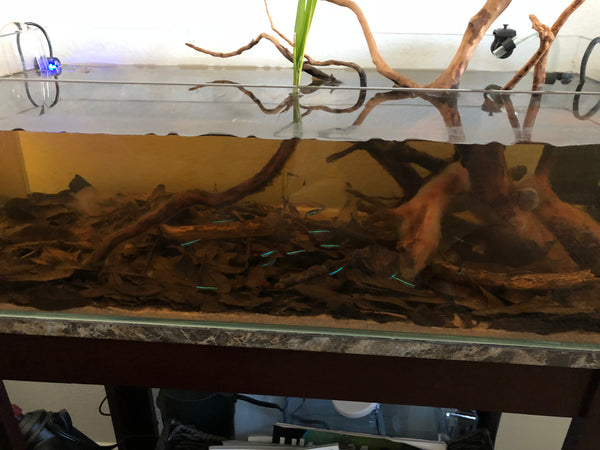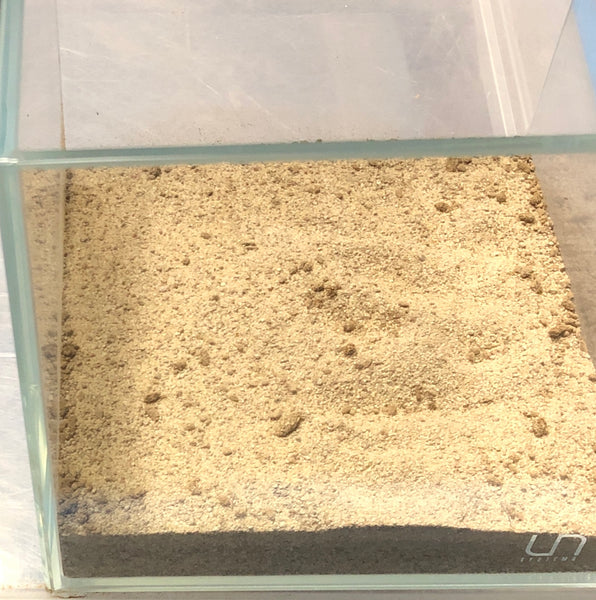- Continue Shopping
- Your Cart is Empty
Challenge
Over the years here at Tannin, we've presented some of the work that we feel has pushed our hobby experience forward, challenged our skills, and questioned the status quo.
Here are a few ideas and their accompanying benefits that YOU can boldly run with and continue the work we started; take it to new levels and unlock some new secrets.
In no particular order:
LEAF LITTER ONLY (LLO) AQUARIUMS
Things to explore: Supplemental/primary food production, denitrification/nutrient export, pH management, fish behavior and spawning, rearing of fry.
The idea here is really not all that complex! In fact, this approach is probably one of the easiest kinds of specialized tanks to create. You set up your aquarium with little to no substrate (if you're going to use substrate, we're talking 1/2"/1.27cm of sand), and add a layer of your fave leaves on top. We're talking anywhere from 1"/2.54cm- 6"/15.24cm deep.
And that's it. Nothing else.

Oh, sure, you could toss a piece of wood in there if you need some "vertical relief" for your aesthetic sensibilities. It's not mandatory, of course. It's purely an aesthetic thing, or perhaps it's something you might want if you're keeping skittish fishes.

However, the main idea is to make the leaf litter the whole "scape"- the entire habitat within the aquarium. In fact, it's less about the "look" than it is about the execution of a concept that can perhaps teach us a few things. By doing this, you're creating an aquarium which mimics the appearance and more important, much of the function of natural leaf litter habitats.
"Extra Credit"- Try "pre-stocking" your tank with organisms like Paramecium, Cyclops, Gammarus, Daphnia, and worms.
"URBAN IGAPO" (IGAPO/VARZEA SIMULATIONS)
Things to explore: Seasonal wet/dry cycles and their influence on fishes, the relationship between terrestrial and aquatic habitats, substrate composition, marginal plant and grass growth, food production
The amazing habitat and it's seasonal inundation cycle has been begging to be replicated in the aquarium for decades. In 2018, I decided to go for it.
In many of the regions of Amazonia, for example-the water levels in the rivers rise significantly during the rainy season often several meters, and the once dry forest floor fills with water from the torrential rain and overflowing rivers and streams.
The Igapos are formed.
Flooded forest floors.
The formerly terrestrial environment is transformed into an earthy, twisted, incredibly rich aquatic habitat, which fishes have evolved over eons to live in and utilize for food, protection, and spawning areas.
To replicate this process in the aquarium is really not difficult. It superficially mimics aspects of the "dry start" method that many aquatic plant enthusiasts play with. Except our goal isn't to start plants for a traditional aquarium. It's to replicate, on some levels, the year-round dynamic of the Amazonian forests.
It starts with a substrate which replicates the composition of the Igapo and Varzea soils of this region. (and yes, we offer them for sale...😆)

Add seed from terrestrial grasses to start the "cycle."

After a few weeks, the seeds should sprout. Once you have a nice growth of grasses, it's up to you as to when to bring on the inundation. At that point, just add water.

And of course, you can add fishes, too. I've experimented with small characins and annual South American killifishes! In fact, the concept lets itself very well to killies. When you're ready to bring on the "dry season again", you simply remove the water gradually. This replicates the desiccation which occurs as the rainy season fades. It's once again a terrestrial habitat.

In fact, in one of my "Varzea" simulations, I'm on my third generation of fishes derived from this wet/dry cycle! (Yes, I remove the adults when Im ready to drain the tank!)

I am personally going to scale this up to a larger (50 US gal) tank soon. There's a lot to learn here. But you have to be really patient, accept some unusual aesthetics, and be willing to do things way differently than you have in the past.
Things to explore: Impact on pH, fostering biofilms and fungal growths, supplemental "grazing" areas for fishes, spawning sites for cichlids and some characins, "nursery" area for fry, nutrient export processes.
they do in Nature.

The idea here is that the substrate becomes a dynamic part of the aquatic ecosystem. Over time, this stuff breaks down and becomes the perfect "microhabitat" for beneficial organisms, like crustaceans, fungal growth, worms, etc.

In other words, in a strictly aesthetic sense, the bottom itself becomes a big part of the aesthetic focus of the aquarium, with the botanicals placed upon the substrate- or, in some cases, becoming the substrate! These materials form an attractive, texturally varied "micro-scape" of their own, creating color, interest, and functions that we are just starting to appreciate.

And the botanical materials in the substrate act, to a certain extent, as "fuel" for the micro and macrofauna which reside in the aquarium, and that they perform this function as long as they are present in the system
Extra-credit- Another one to try pre-stocking with crustaceans and other microorganism cultures. A neat one to attempt spawning of egg-scattering fishes in...Will this matrix of material provide a "built-in" first food source for fry? Maybe?
Things to explore: Utilization of very rich substrate materials, decomposing leaf litter, live mangroves, simulation of food webs, alternative aesthetics.
Our focus is on trying to replicate and understand the complex web of life that occurs in brackish water habitats, and we've started to evolve the practice and appreciation of this unique niche just like we've all done with blackwater. In fact, the approach that we take to brackish is unlike what has previously been taken before, but one that is incredibly familiar to you as "tint enthusiasts."
And of course, there are a few components which, in our opinion, "power" the brackish water, botanical-style system: Mud, leaf litter...and mangroves. A more realistic and functional representation of this ecological niche.

And once again, it starts with the substrate. A richer, muddier, more sedimented material; one which fosters microbial life and decomposition of botanical materials. The idea being to help develop a "food web" which can provide supplemental nutrition for the fishes. One which will foster strong growth of mangroves.

Encouraging- rather than discouraging- leaf litter accumulation and it's resulting detritus is something that we feels sets this approach apart from the sterile "grey/white sand and rock" approach which has been proffered for decades.
As in- not your father's brackish-water aquarium. It's not about limestone rocks, quartz sand, and pieces of coral skeleton. Rather, we use combinations of fine sands, muds, leaf litter, and other materials to create a rich, dark, sediment-filled substrate. Possibly creating higher nutrient conditions than typically associated with brackish tanks, yet far closer in step with the rich estuary habitats we're interested in replicating.
Yeah, leaf litter. We all know a bit about that, huh?
And of course, the water will take on a tinted look in many cases, because of the leaves and mangrove bark which accumulate within the aquarium. The aesthetics are a radical departure from the conventional brackish tank- but the goal is, too. In this case, it's to foster a more dynamic ecosystem, to explore the unique relationship between substrate, plants, and water.

Applying the lessons we've learned in the freshwater botanical-style aquarium and using them in this different milieu is exciting and perhaps even a bit challenging. It requires mental shifts to embrace decomposition, detritus, etc. All things which can help us create a radically different type of brackish water aquarium than we have in the past.

Extra Credit- Creating "tidal shifts" via pumps and solenoids, growing intertidal salt-tolerant marginal plants, culturing shrimp and other crustaceans within the leaf litter bed, varying specific gravity over time to full-strength marine water, seagrass propagation (in marine water versions).
So, that's a few of the cool areas we as a community can work with. A few of the challenges we can take on. There are many, many more, of course.
There is so much interesting stuff out there to study and replicate in our aquariums. Not just to "diorama it up" to win a biotope aquarium contest; no- but to replicate the form and function of these unique habitats. I say this over and over and over again, because it's a completely different mindset.

I think we need to spend much more time really trying to get our hands around why natural habitats are the way they are. To understand why they formed, how they "operate", and what set of unique characteristics they possess which makes them home to our fishes.
Trying these alternative approaches and ideas- taking on the challenges- will only serve to advance our skills, benefit the hobby at larger, and help us as a community stay at the bleeding edge of aquarium practice for years to come.
What challenges will you take on in 2021?
Stay brave. Stay creative. Stay curious. Stay motivated...
And Stay Wet.
Scott Fellman
Tannin Aquatics








Scott Fellman
Author